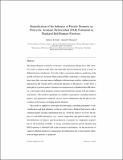| dc.contributor.author | Stark, Addison K | |
| dc.contributor.author | Ghoniem, Ahmed F | |
| dc.date.accessioned | 2021-10-27T20:05:12Z | |
| dc.date.available | 2021-10-27T20:05:12Z | |
| dc.date.issued | 2017 | |
| dc.identifier.uri | https://hdl.handle.net/1721.1/134479 | |
| dc.description.abstract | © 2017 The thermochemical conversion of biomass via gasification and pyrolysis offer attractive routes to drop-in-ready fuels and renewably-derived chemicals from a variety of different biomass feedstocks. For both of these conversion pathways prediction of the growth of Polycyclic Aromatic Hydrocarbon (PAH) compounds is of particular importance since they can cause major challenges in downstream catalytic synthesis reactors and decrease the overall carbon conversion efficiency of the process. In this work, a multi-physics particle model of biomass devolatilization in a fluidized bed (FB) Reactor is developed which integrates external and internal heat transfer with devolatilization kinetics. This model is dependent on a number of parameters, including chemical kinetics and operational conditions such as reactor temperature and the physical description of the biomass including particle diameter. This model is applied to investigate the prevailing controlling parameters of devolatilization and their influence on the tar yields from a fluidized bed reactor and is validated against existing experimental data (Gaston et al., 2011). From this analysis we assess the impact of controllable parameters (e.g. reactor temperature and particle radius) on the devolatilization of biomass and the production of primary tar compounds responsible for the formation of PAHs. A strong correlation between particle diameter and PAH formation is identified and a physiochemical mechanism, via the production of sinapoyl aldehyde during low-temperature devolatilization due to heat transfer limitations in larger particles, is proposed. | |
| dc.language.iso | en | |
| dc.publisher | Elsevier BV | |
| dc.relation.isversionof | 10.1016/J.FUEL.2017.06.020 | |
| dc.rights | Creative Commons Attribution-NonCommercial-NoDerivs License | |
| dc.rights.uri | http://creativecommons.org/licenses/by-nc-nd/4.0/ | |
| dc.source | Other repository | |
| dc.title | Quantification of the influence of particle diameter on Polycyclic Aromatic Hydrocarbon (PAH) formation in fluidized bed biomass pyrolysis | |
| dc.type | Article | |
| dc.contributor.department | Massachusetts Institute of Technology. Department of Mechanical Engineering | |
| dc.relation.journal | Fuel | |
| dc.eprint.version | Original manuscript | |
| dc.type.uri | http://purl.org/eprint/type/JournalArticle | |
| eprint.status | http://purl.org/eprint/status/NonPeerReviewed | |
| dc.date.updated | 2019-09-26T14:31:01Z | |
| dspace.orderedauthors | Stark, AK; Ghoniem, AF | |
| dspace.date.submission | 2019-09-26T14:31:01Z | |
| mit.journal.volume | 206 | |
| mit.metadata.status | Authority Work and Publication Information Needed | |
